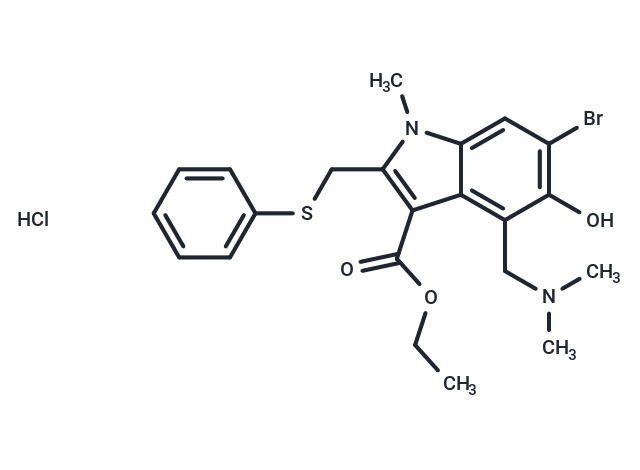Shopping Cart
- Remove All
 Your shopping cart is currently empty
Your shopping cart is currently empty

Umifenovir hydrochloride (Arbidol HCl) , an broad-spectrum antiviral chemical agent, can inhibit cell invade of enveloped viruses by blocking viral fusion with host cell membrane.

| Pack Size | Price | Availability | Quantity |
|---|---|---|---|
| 5 mg | $37 | In Stock | |
| 10 mg | $50 | In Stock | |
| 25 mg | $86 | In Stock | |
| 50 mg | $145 | In Stock | |
| 100 mg | $230 | In Stock | |
| 200 mg | $338 | In Stock | |
| 1 mL x 10 mM (in DMSO) | $50 | In Stock |
| Description | Umifenovir hydrochloride (Arbidol HCl) , an broad-spectrum antiviral chemical agent, can inhibit cell invade of enveloped viruses by blocking viral fusion with host cell membrane. |
| Targets&IC50 | RNA viruses(FLU-A, RSV, HRV 14 and CVB3, enveloped and non-enveloped):2.7-13.8 microg/ml |
| In vitro | Arbidol inhibits the cell entry of HCV pseudoparticles of genotypes 1a, 1b, and 2a in a dose-dependent fashion. Arbidol also displays a dose-dependent inhibition of HCV membrane fusion, as assayed by using HCV pseudoparticles (HCVpp) and fluorescent liposomes. [1] Arbidol is found to present potent inhibitory activity against enveloped and non-enveloped RNA viruses, including FLU-A, RSV, HRV 14 and CVB3 when added before, during, or after viral infection, with IC50 ranging from 2.7 to 13.8 mg/mL. Arbidol shows selective antiviral activity against AdV-7, a DNA virus, only when added after infection (therapeutic index (TI) = 5.5). [2] Arbidol induces changes to viral mRNA synthesis of the PB2, PA, NP, NA, and NS genes in MDCK cultures infected with influenza A/PR/8/34. [3] Arbidol interacts and modifies the physicochemical properties of the phospholipids in the membrane, having a significant effect on negatively charged phospholipids but a minor one on zwitterionic phospholipids. Arbidol is located at the interface of the membrane, participates in hydrogen bonding either with water or the phospholipid or both, and decreases the hydrogen bonding network of the phospholipids giving place to a phospholipid phase similar to the dehydrated solid one. [4] Arbidol is found to have potent inhibitory activity against HTNV when added in vitro before or after viral infection, with IC50 of 0.9 mg/mL and 1.2 mg/mL, respectively. [5] |
| Alias | Arbidol hydrochloride, Arbidol HCl |
| Molecular Weight | 513.88 |
| Formula | C22H25BrN2O3S·HCl |
| Cas No. | 131707-23-8 |
| Smiles | Cl.CCOC(=O)c1c(CSc2ccccc2)n(C)c2cc(Br)c(O)c(CN(C)C)c12 |
| Relative Density. | no data available |
| Storage | Powder: -20°C for 3 years | In solvent: -80°C for 1 year | Shipping with blue ice/Shipping at ambient temperature. | |||||||||||||||||||||||||||||||||||
| Solubility Information | Ethanol: 21 mg/mL (40.87 mM), Sonication is recommended. DMSO: 45 mg/mL (87.57 mM), Sonication is recommended. H2O: < 1 mg/mL (insoluble or slightly soluble) | |||||||||||||||||||||||||||||||||||
Solution Preparation Table | ||||||||||||||||||||||||||||||||||||
Ethanol/DMSO
DMSO
| ||||||||||||||||||||||||||||||||||||

Copyright © 2015-2025 TargetMol Chemicals Inc. All Rights Reserved.